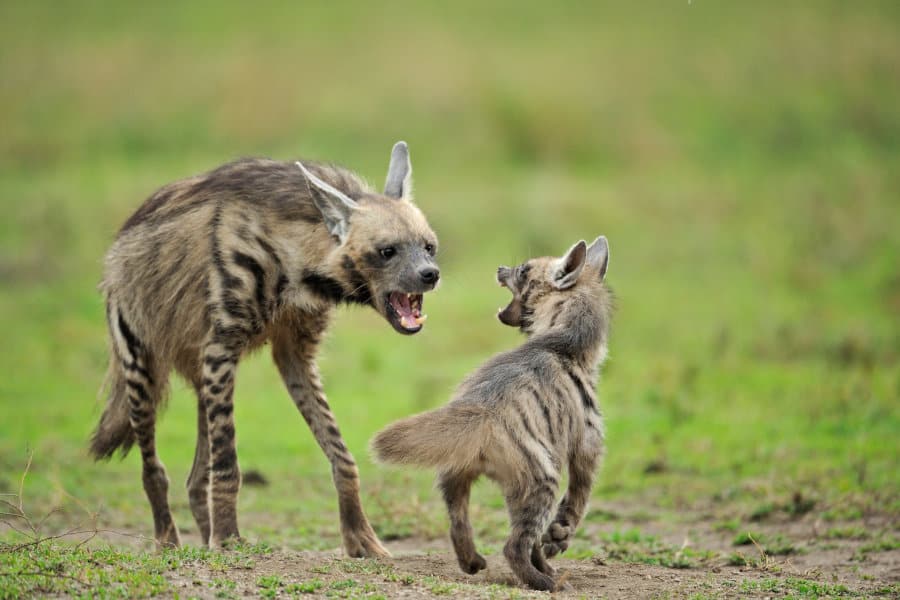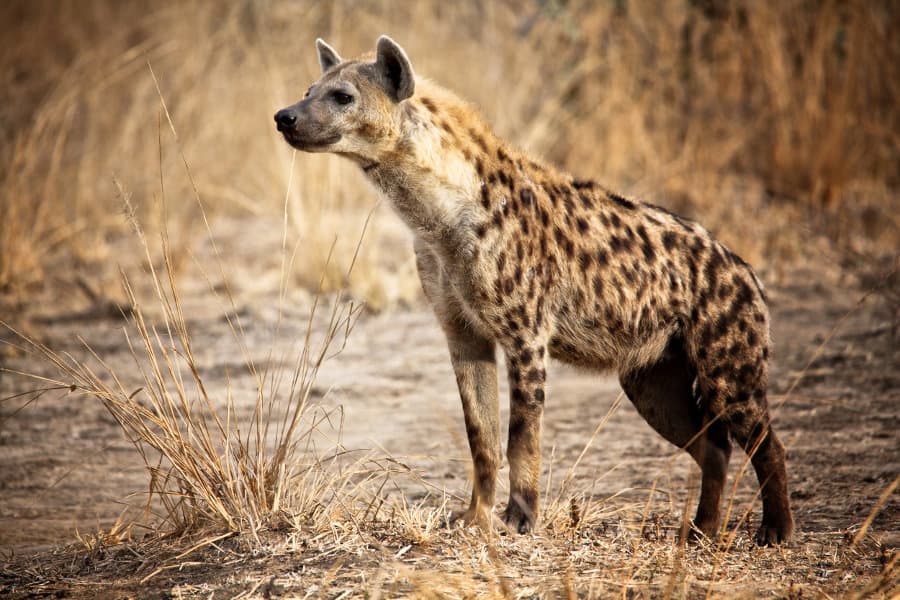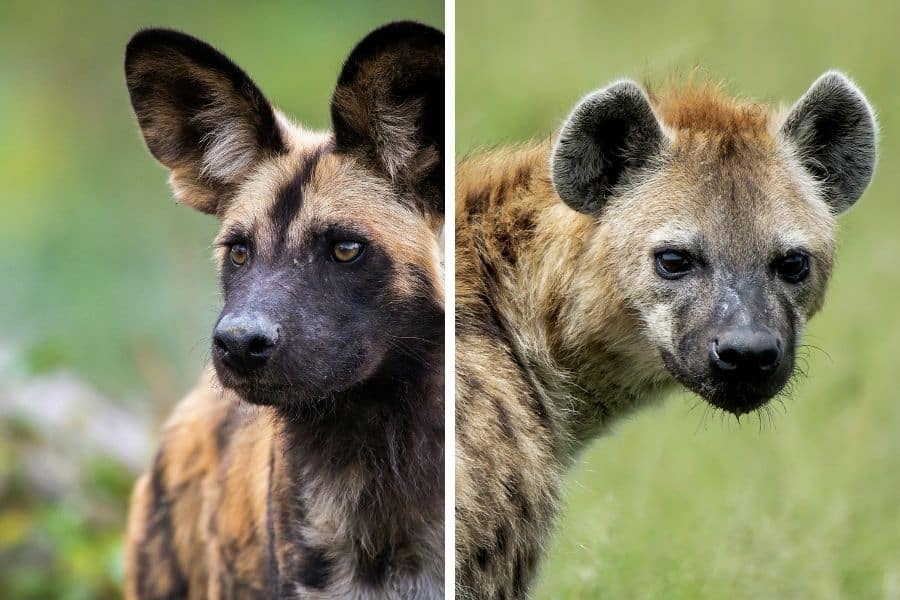Striped hyena have a bad rep.
To some, they are ugly scavengers. To others, these incredible animals are a myth, a snarling monster in a Disney movie, a grave robber, or a laughing carnivore.
Popular culture has told us to dislike striped hyena. But look a little closer because these African animals are one of the world’s most useful species.
Find out why with these incredible striped hyena facts.
Facts About Striped Hyenas
Seeking some striped hyena fun facts?
From their strong stomachs and diets to their soft striped fur, let’s uncover the truth about these misunderstood creatures.
It is one of three African hyena species
Spotted hyena are widespread across sub-Saharan Africa. They are larger and the most commonly encountered hyena on an African safari. It is this species that has the distinctive laughing call.

Brown hyena are incredibly rare, with just a few isolated populations across southern Africa. Spotting one of these would be the top of almost any safari connoisseur’s list.
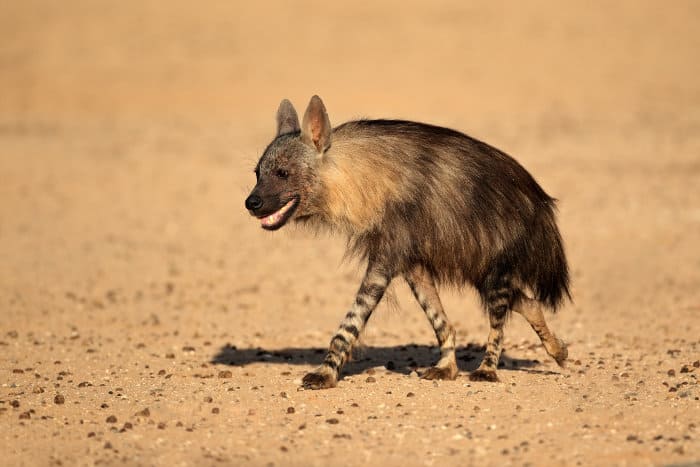
Striped hyena are the smallest of the hyena species and are very different from their cousins. We will find out why through the facts below.
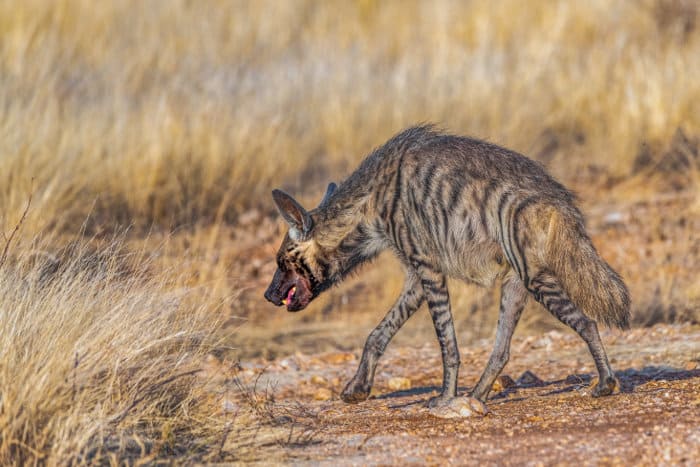
The Bible mentions the African striped hyena
These incredible animals used to be widespread, especially across the Middle East. Early Hebrew versions of the Bible mention them.
These are referred to as zevoa or tzebua. Literally translated, this means “howling creature.”
Even in the Bible, these animals didn’t receive any credit. In Ecclesiasticus 13:18, the Bible suggests that they are powerful yet cowardly.
Or see the original version of Jeremiah 12:9 – “Is my heritage to me like a hyena’s lair? Go assemble all the wild beasts, bring them to devour.”
Striped hyena & black magic – they are not grave robbers
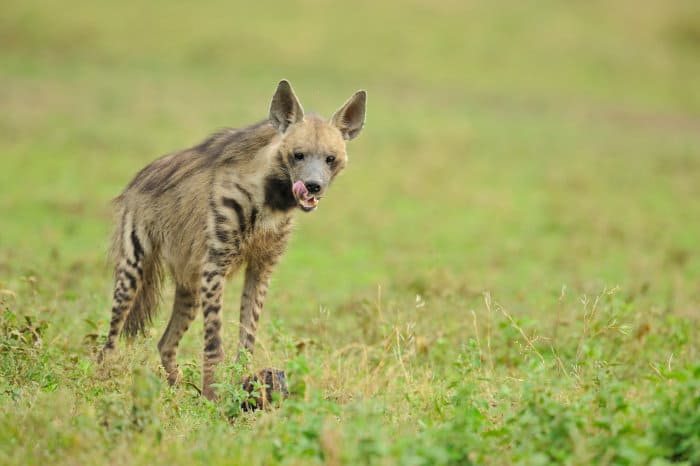
Part of their early legend links to cult and magic. This continues today.
Many cultures believe that striped hyenas rob graves, scavenging on dead carcasses deep in the night. This, of course, is little more than a fanciful tale.
It is true that striped hyenas scavenged on human corpses during times of war.
This took place in Turkey, where people placed stones on top of war graves to prevent hyenas from digging out bodies. The behavior was also widely reported during wars in Lebanon.
However, this was during wartime, when a lot of people died, and many weren’t buried properly.
It is natural for an expert scavenger to find a mass grave and feed on the corpses.
It is not true that these animals visit village cemeteries to dig out victims.
Striped hyenas do not transport witches

In certain Arab cultures, it’s believed that striped hyena can cast spells on people before eating them alive in a cave.
In many parts of northern India, striped hyena are known as the horse of witches.
Folklore suggests that witches ride on the back of striped hyena. When the carnivore scavenges a human carcass, the witch devours the soul of the deceased.
Striped hyenas are not vampires
Even worse, old Persian folklore considered these animals to be vampires.
After mesmerizing their victims using a pungent-smelling liquid, the hyena would suck blood from their necks.
Striped hyena parts feature in traditional medicines

Being touched by the devil is pretty powerful stuff, or so certain cultures believe.
That’s one reason why striped hyena body parts are commonly used in traditional medicine.
In some beliefs, you can use a striped hyena penis as a talisman to boost male fertility.
In others, their skulls are ground up and used to heal various ailments.
The feet and brains have special powers that only a traditional doctor can know about.
Their skins are also revered and can fetch a lot of money on the black market. For example, the fur is an irresistible charm in Iranian folklore, forcing everyone to yield to its owner.
Here are some other examples of striped hyena parts being used in folklore magic:
- In Iran, people sometimes wear a hyena bone on the upper arm as a form of protection.
- Back in the times of Ancient Greece and the Roman Empire, wearing a striped hyena anus on the upper arm made a man irresistible to women.
- Around the Khyber Pass – between Afghanistan and Pakistan – rubbing burned striped hyena fat onto the genitals increases sexual potency.
- People eat that same fat in parts of India as a natural medicine against rheumatism.
- Eating the tongue and drinking the blood can fight tumors in parts of northern India.
- Keeping a striped hyena penis in vermilion powder helps its male owner have multiple lovers.
Hyena meat is halal in Islamic culture
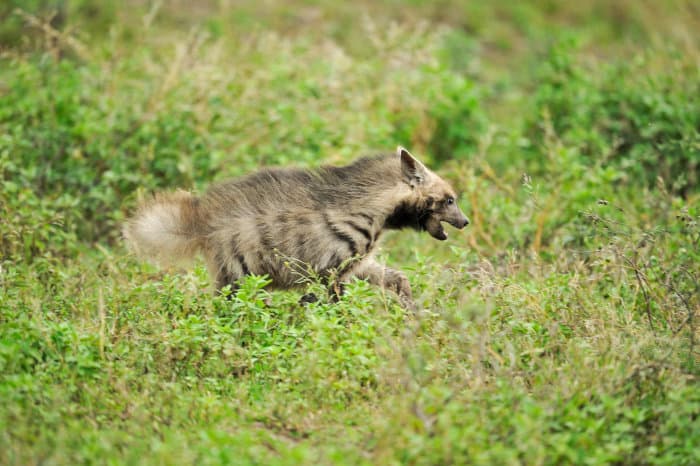
Eating hyena has also been considered an aphrodisiac. Even though the animal is completely wild, its meat is considered halal or lawful in Islamic culture.
This has been particularly prominent in areas of Pakistan and Somalia, where striped hyena meat has become a pricey delicacy.
Less than 10 000 striped hyena remain in the wild
It really doesn’t look good for the striped hyena. They are almost universally disliked, completely misunderstood, and their body parts often sold for decent sums of money.
Now they are on the hit list of professional poachers as well as being regularly killed in traps set up by villagers.
All that means that less than 10 000 of them remain in the wild. Despite this incredibly low number, they are only classified as near threatened on the IUCN red list.
Striped hyenas live alone rather than in clans
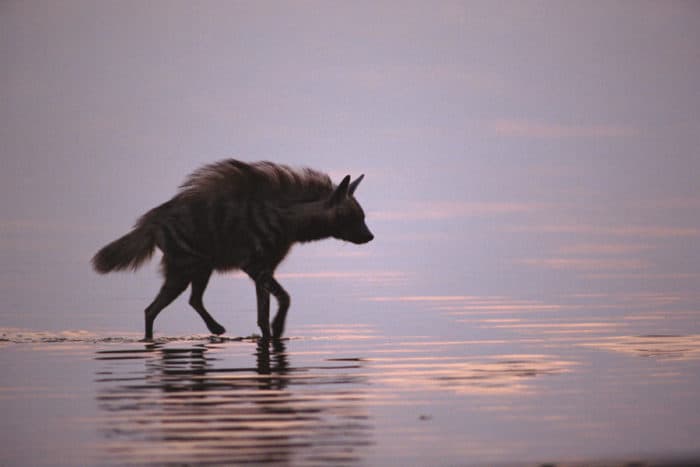
Spotted hyena can move in clans of over 50, especially on East Africa’s open grasslands. They are social animals and will allow rivals to pass through their territory.
Striped hyena live alone or in pairs. If they do live in clans, the maximum number is six.
That makes them very difficult to track, so the actual number of animals in the wild remains unknown.
There is a good chance that the population is closer to 5000.
Striped hyena occur in North and East Africa, the Middle East, and India

While living in tiny numbers these incredible carnivores still exist in almost two dozen countries.
They occur deep in the Sahara, in the deserts of Saudi Arabia and Oman, plus Yemen, Iran, Israel, Lebanon, Syria, Pakistan, and India.
Unfortunately, many of these countries have been hostile for humans to live. And ideas of animal conservation slip way down the list during times of war.
Kenya and Tanzania are the best countries for seeing striped hyena on a safari. Here they compete with larger spotted hyena, causing them to exist on the fringes of national parks and wilderness areas.
Striped hyenas are the ultimate scavengers
Despite popular stereotypes, spotted hyena hunt most of their food. They are large carnivorous predators.
Striped hyena are much smaller and don’t have the same ability to take down prey. Yet they do have an incredible capacity to find a meal.
They will eat almost anything, especially rotting flesh and the kind of filth that even pigs would avoid. In this regard, they are like African vultures, eating the meat and flesh that others can’t stomach.
Striped hyena stomach acid pH is incredibly low

How is it possible to eat rotting flesh and feces?
A strong stomach is the secret.
Striped hyenas have a high concentration of hydrochloric acid in their stomachs, as shown by a very low pH level.
Like other scavengers, the striped hyena’s stomach acid pH level is less than two. This is low when compared with human stomachs, which have a pH level closer to three.
This acidity destroys bacteria before it reaches the intestines. It’s like a filter that stops all the bad bacteria from multiplying.
So rather than getting sick from eating rancid meat, striped hyenas find an everyday meal. Still, even though their diet is free-range, it’s hard to imagine that hyena meat is palatable to humans.
Their stomachs are matched by a strong jaw and teeth. They will crush skeletal remains into small pieces and crunch through the toughest skin and bone.
What do striped hyenas eat
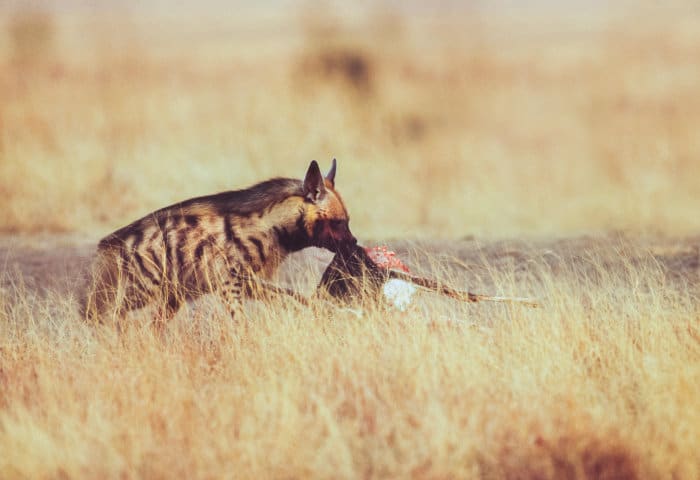
While it’s known that they are scavengers, what exactly does the striped hyena’s diet consist of?
The majority of the animal’s diet comprises carrion.
More specifically, the decaying flesh of various mammals such as zebras, impalas, wildebeest, and other ungulates. They are also known to eat insects and fruits, including melons and dates.
But what do striped hyenas drink?
Interestingly, these animals are capable of drinking both salt and fresh water. The hyena’s digestive system is even capable of handling soda.
The animal that cleans our environment
Why is scavenging always considered a bad thing?
Striped hyenas clean the environment. They eat the flesh and filth that other animals leave behind. This accelerates decay and destroys nasty bacteria that could filter into the soil and water.
So rather than detesting these animals for scavenging, we should be celebrating their role in the cycle of life.
Just think: without expert scavengers there would be more rancid bacteria for everything and everyone else to deal with.
Striped hyena fur is incredibly soft

Soft, dense, beautiful – it’s easy to see why the fur is so desirable. It would be a delight to stroke such fur, except these are wild animals and they have an incredible defense.
Despite their name, striped hyenas don’t always have clearly visible stripes upon their mane, certainly not like defined zebra stripes.
The stripes are most conspicuous along their flank and legs. Some striped hyenas are more striped than others.
The coat is a soft gray-brown color, lighter around the legs and darker across the mane.
It’s enlivened by a large black neck spot – it’s this distinguishing spot that is best used to identify the species from its cousins.
Striped hyena are nocturnal animals

After spending the day in their den, these animals usually emerge in complete darkness.
They explore wide territories, including coming into contact with villages. But they don’t risk being seen. Typically these hyena will have returned to their den long before sunrise.
Striped hyena eyesight is sharp
It’s a myth that striped hyena have an excellent sense of smell, although it’s easy to understand why the myth circulated.
Most canines have great olfactory organs. However, hyenas are not canines, nor are they cats. They have their own animal family: Hyaenidae.
Rather than smell, the striped hyena relies on its acute eyesight.
But can hyenas see in the dark?
When the world goes dark, these animals can still see very well. Striped hyena eyes are sharp, so they find their food by sight – picking up on the slightest movements, many miles away.
Striped hyena mass is around 35 kg for adults

That’s not very big for a carnivore. Large males weigh up to 55 kg, but 35 kg is the average.
They are around one meter in length and 70 cm at the shoulder. Add on a 30 cm tail, and it’s still a small animal, certainly much smaller than the largest antelope species in Africa.
Striped hyena predators
A striped hyena’s size is nothing compared to some of Africa’s top predators. As such, this small size makes them potential prey for other carnivores, including clans of spotted hyena.
They are sometimes attacked by lions and leopards, not just to eat but to remove the competition from their territories.
Still, how is this for an ingenious defense?
Striped hyena don’t fight back. Instead, they turn their anus inside out and spray a foul-smelling liquid at their attackers!
The hyenas can’t smell it, yet their attackers have finely tuned nostrils. Unfortunately, such a defense is no match for human predators with snares and guns.
Striped hyenas have a monogamous relationship

Many of Africa’s carnivores must climb to the top before getting the chance to mate. Even worse, young males are often kicked out, so they don’t have a chance to develop and compete for the pride’s females.
Striped hyena are much more like ourselves. They develop monogamous relationships and raise their young together.
Everything is shared, from establishing the den to feeding the cubs. The cubs stay with their parents until they are independent and can source their own food.
Eventually the youngsters wander off, and the monogamous relationship breaks down, leaving all three of the family on their own (again, not dissimilar to human family relationships).
Striped hyenas live until the age of 12
In captivity these animals can live until they are more than 20.
It’s harder in the wild, and anything over ten is considered old.
African Striped Hyena Need Our Help
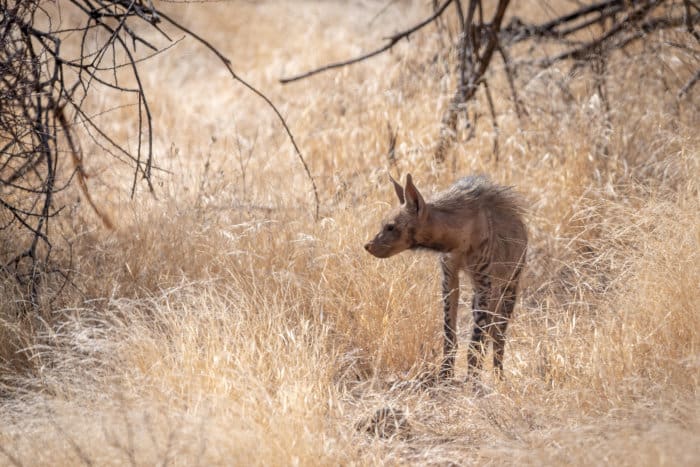
While it may be humorous to read of vampires, grave robbers, and talisman charms, the reality is bleak for these ancient animals.
Striped hyena are being hunted, and their population has been declining by 10% every 30 years. Habitat destruction is another major problem, especially with new quarries and mines wiping out their dens.
These animals need our support. They have to be visible and understood. So share the word, and let’s tell the world about this misunderstood legend.
For a chance to see the striped hyena in the wild, check out these incredible African safari deals.
